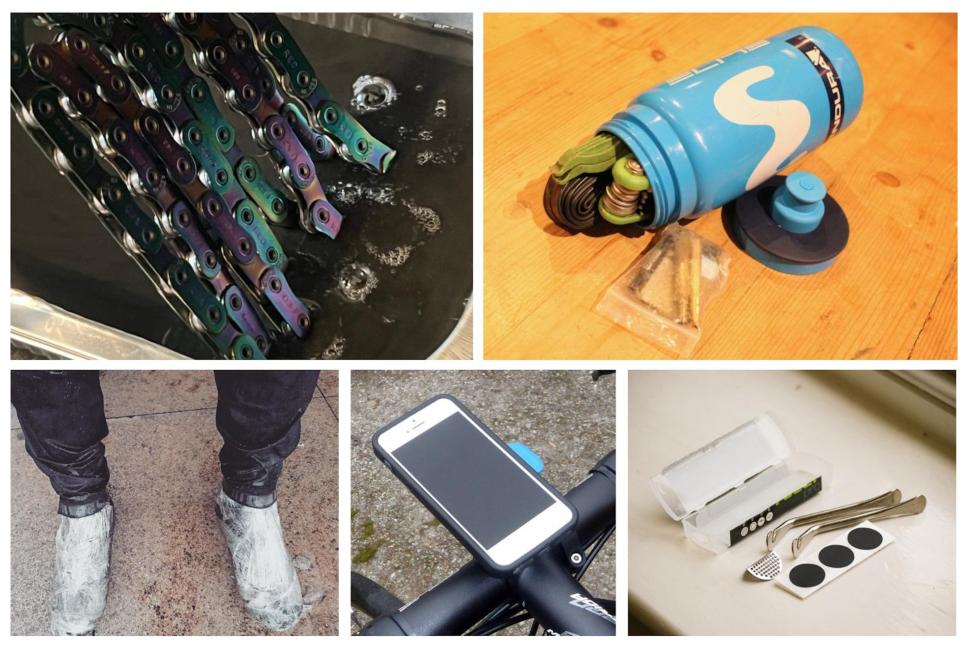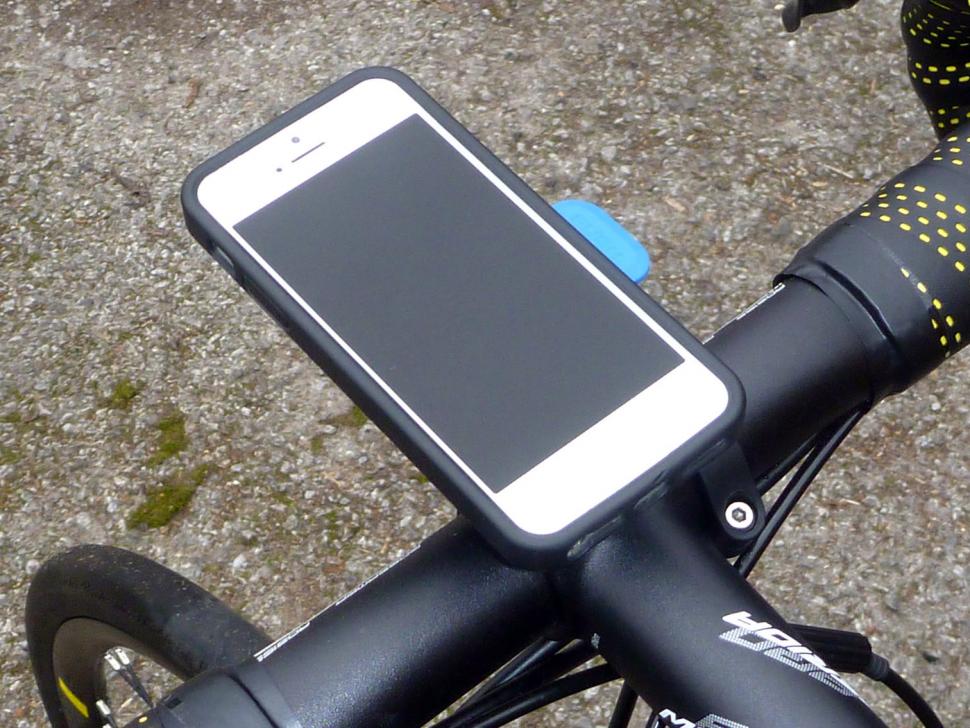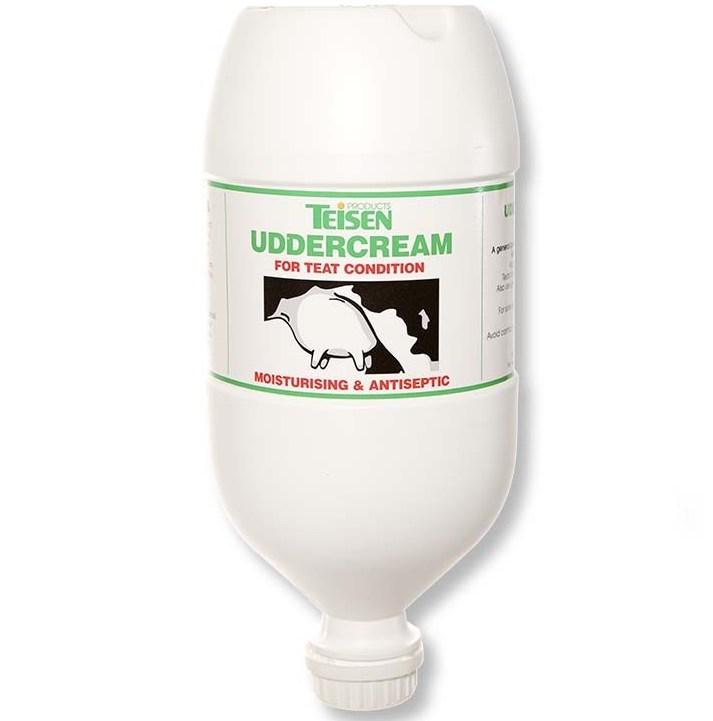- News
- Reviews
- Bikes
- Accessories
- Accessories - misc
- Computer mounts
- Bags
- Bar ends
- Bike bags & cases
- Bottle cages
- Bottles
- Cameras
- Car racks
- Child seats
- Computers
- Glasses
- GPS units
- Helmets
- Lights - front
- Lights - rear
- Lights - sets
- Locks
- Mirrors
- Mudguards
- Racks
- Pumps & CO2 inflators
- Puncture kits
- Reflectives
- Smart watches
- Stands and racks
- Trailers
- Clothing
- Components
- Bar tape & grips
- Bottom brackets
- Brake & gear cables
- Brake & STI levers
- Brake pads & spares
- Brakes
- Cassettes & freewheels
- Chains
- Chainsets & chainrings
- Derailleurs - front
- Derailleurs - rear
- Forks
- Gear levers & shifters
- Groupsets
- Handlebars & extensions
- Headsets
- Hubs
- Inner tubes
- Pedals
- Quick releases & skewers
- Saddles
- Seatposts
- Stems
- Wheels
- Tyres
- Health, fitness and nutrition
- Tools and workshop
- Miscellaneous
- Buyers Guides
- Features
- Forum
- Recommends
- Podcast
 everyday alternatives to expensive cycling kit
everyday alternatives to expensive cycling kitCycling hacks on a budget: our top everyday alternatives to expensive cycling kit
While most of us like to treat ourselves to cool new bike stuff from time to time, bike-specific products can be expensive. It's all too easy to get lured into costly magical claims made by manufacturers, so here are some everyday alternatives that you might already have at home, offering the same functionality at a fraction of the cost.
When deciding where to spend your money, it's important to prioritise items that will directly impact your safety and comfort on the bike, such as a decent set of bike lights and a good pair of cycling bib shorts.
It's also worth checking out second-hand bikes and gear. You can often find high-quality equipment at a fraction of the price from Facebook Marketplace, eBay, local bike shops and cycling clubs.
Without further ado, here are our top tricks to keep you riding without breaking the bank. We've also added some road.cc reader tips in from previous versions of this article.
Make your own energy drink
There's a plethora of options when it comes to energy drinks, and while you can often pick up energy powders in bulk for some pretty good deals, you can also make your own energy drink using a couple of common household items.
Energy drinks contain carbohydrates, and their purpose is to boost your energy levels. They will usually provide large amounts of carbohydrates, as well as fluids.
A DIY energy drink is really easy to make. One recipe includes 100ml of fruit squash, 900ml of water and 1/4 tsp of salt. You could also use 250ml of fruit juice, 750ml of water and 1/4 tsp of salt.
Both fruit squash and fruit juice serve as a great source of carbohydrates and sugars, providing a quick energy boost during rides. The inclusion of salt also has multiple beneficial purposes. Salt helps to absorb and retain fluid helping to maintain hydration levels during exercise. It also lowers the freezing point of water, preventing your drinks from freezing in colder temperatures.
Repair punctured inner tubes
Repairing punctured inner tubes is not only a cost-effective solution, but also a more environmentally friendly approach to maintaining your bike. Velorim, which runs The National Bicycle Tyre Recycling Scheme, says that in the UK over 9,300 tonnes of tyres and inner tubes go to landfill every year.
> How green are your bike tyres?
Investing in a puncture repair kit will only cost you a few quid, and doesn't mean you have to fix the punctures roadside. You can gather up your punctured inner tubes and dedicate a wet winter afternoon to fixing them. A patched tube can be just as dependable as a new one, as long as the patch is done well.
It's also worth considering repairing minor cuts in your tyres to extend their longevity. For larger cuts where the inner tube pokes through once the tyre is inflated, you can glue an inner tube patch on the inner surface of the tyre, like patching a tube. Superglue is also a solution for small cuts, while gel wrappers can serve as a temporary solution when you're out on a ride.
Use your phone as a GPS bike computer...
A GPS bike computer on the handlebar makes a lot of sense for a lot of people, but the smartphone that you're probably already carrying in your pocket has a huge navigational capability and will do a great job for some. Use an app that allows you to download and save maps when you have access to WiFi and you won't eat into your data allowance either.
You'll need a mount for your mobile – something like a Quad Lock Bike Kit — but that'll be cheaper than shelling out on a bike computer.
Understandably though, a lot of you won't want to stick your smartphone on your handlebars due to the risk of damaging an expensive device. Instead, "an old, unwanted smartphone makes a perfectly functional bike computer. Bonus: stick your SIM card back in it and you have an emergency phone," says one of our readers, Tim Meyrick.
...or store it in a freezer bag
Most modern smartphones are waterproof, but if you want to protect yours from getting scratched in your pocket you can use a a freezer bag/snack bag instead of a brand name wallet.
A Ziploc Snack Bag, for instance, measures 16.5cm x 8.2cm so will fit perfectly into most jersey pockets, and it has a sealed top. Go to any supermarket and you'll find various options in different sizes, some more durable than others.
Wrap your feet in cling film or tin foil
These two hacks use items commonly found in kitchen cupboards and are reserved for the worst weather days.
For those unfortunate moments where you rip a hole in your waterproof overshoes, you could consider wrapping a layer of cling film around your shoes to help keep the rain out or use freezer bags inside your shoes, albeit at the expense of breathability (and aesthetics).
This can also be extended to waste from other goods with one of our readers suggesting wrapping your feet in the empty plastic bag from bagels.
For those who suffer from cold feet, a layer of tin foil wrapped around the outside of your socks will help to keep the heat in on very cold rides. While keeping the foil in place during a ride may prove challenging, this trick may offer some respite during those super cold days out.
Use safety glasses
You can buy safety specs from any DIY store for £2 or £3. Bollé even makes some, like the Ness+, with a sporty look and a scratch and fog resistant coating. You can pick up a pair for as little as £4.50 online, or check out our guide to the best cheap cycling sunglasses if you want something slightly more stylish without breaking the bank...
Make your own on-the-bike snacks (or buy cheaper alternatives)
Maintaining your energy levels throughout a ride is crucial, and while branded energy bars or gels are a common choice, preparing homemade snacks is a great cost-effective alternative. They can require minimal preparation and the freedom to customise recipes to your preferences.
If you need some inspiration you can find numerous recipes online. A quick and easy one I like is making energy balls from oats, peanut butter and dark chocolate. This is a no-bake recipe and you simply store them in the fridge. Choosing natural ingredients not only tends to be easier on the stomach but also proves more economical and can yield tasty results, all while offering a high-energy snack for your rides.
All that said, if it's just an energy hit you need then some everyday products have very similar nutritional data to sports-specific energy bars. Three McVitie's Fig Rolls deliver 37.2g of carbs (18.9g of which are sugars), 2.4g of protein and 4.5g of fat, and you can get a whole 200g pack from Sainsbury's for £1.45 at the time of writing, with own-brand versions even cheaper still. Bargain!
Use udder cream instead of bike-specific chamois creams
Yes, udder cream; cream for udders. As the name suggests, it's designed to maintain good udder condition in dairy cows. Moisturising and often antiseptic, it's also a cheap alternative to chamois cream.
Chamois cream reduces friction between your skin and clothing, and so avoids chafing. It can be quite expensive, though — compared to udder cream, at least. Teisen Uddercream will set you back around £21.50 for 2.5 litres, or four quid for a 200ml tube if you don't want or need that much.
Stash your tools and spares in an old bottle
> The rising price of entry-level road bikes
Stashing your tools and spares in an old bottle is a budget-friendly solution and while a dedicated tool holder bottle doesn't cost a whole lot, the chances are that you have an old bottle kicking about that'll do the job equally well.
There are a few ways to set it up: opt for a wide-necked bottle for easy access, preventing your tools from getting stuck, or use a tall bottle and cut it in two using the top half as the lid section. Alternatively, you can create a hinge by cutting the bottle lengthwise, allowing you to wrap your tools in a bag inside and secure them with the lid.
Use a pencil case as a tool roll
A standard pencil case has plenty of capacity for tools, and can fit in most jersey pockets. We've heard of cyclists being able to get an inner tube, multitool, two tyre levers, a CO2 pump and two canisters inside £1 pencil cases from the supermarket.
"Last year I got a Muc-Off wash bag for Christmas that I now use it as a tool bag in my panniers," says road.cc reader Wolf Simpson.
Full-fat milk and a banana for recovery
One pint of full fat milk, gone! I do not drink recovery shakes. Milk, milk and more Milk. pic.twitter.com/xal5KWH9a1
— Dame Laura Kenny (@LauraKenny31) June 7, 2021
Since branded protein drinks can be expensive, it's worth considering a pint of full-fat milk, as Dame Laura Kenny did, paired with a banana for post-cycling recovery. They provide a balance of carbohydrates and protein, along with vitamins and minerals to support your body's recovery needs.
A glass of milk and a banana is often more cost-effective and like making your own energy snacks, they can be gentler on the stomach, as long as you don't have any intolerances. You could also try chocolate milk: a 400ml bottle of Yazoo gives you 36.4g of carbs, 13.2g of protein and 260kcal of energy, while a 400ml bottle of Muller Frijj Chocolate Milkshake gives you 44g of carbs, 13.2g of protein and 300kcal of energy. They cost between £1-£1.50 each from a supermarket.
Washing up liquid for bike cleaning
> How to clean your bike - from a quick lick to a full makeover
Using washing up liquid and water to clean your bike is a budget-friendly alternative to expensive cycling-specific cleaning products. While there are many debates about its suitability, many cyclists would argue that washing up liquid and water do a great job for general bike cleaning.
However, it's important to note that washing up liquid typically contains salt which can potentially harm delicate bike components if not used properly. To mitigate this risk, it's crucial to dilute the washing up liquid with an adequate amount of water and ensure you rinse it off thoroughly afterwards.
Similarly, when it comes to cleaning tools like sponges and cloths, you don't always need to invest in cycling-specific products. Old towels can work just as effectively, along with a variety of sponges and scourers from budget-friendly stores like Poundland.
Water bottle mudguard
In the UK, there is a risk of showers all year round, so DIY 'ass savers' make for a great solution to protect yourself from some of the inevitable road spray.
If you have a stash of old water bottles gathering dust in the back of your cupboard, don't throw them out just yet. With a few minutes and some creative cutting, you could fashion one into a practical and cost-effective ass saver mudguard.
Bonus points if you have a pro's bottle that you've picked up from a road race to add to the aesthetics.
The power of Paraffin
> Your complete guide to waxing your chain
While not an environmentally-friendly option, some cyclists turn to paraffin wax as a cost-effective alternative to cycling-specific chain wax. Despite its environmental implications, numerous enthusiasts in online forums attest to its effectiveness.
One cyclist writes, "Wax is wax. In theory, some of the additives from bike specific stuff reduces friction, but I would guess there is way more improvement from regular oil-based lubes to wax than there is from the additives.
"For me waxing chains is about avoiding the black mess and not having to lube every ride during the summer when the dust is like flour. If I happen to go faster, well, that is a bonus."
You could also consider paraffin in its liquid form as a cheap chain degreaser. Take the chain off your bike and soak it in a shallow dish of paraffin (some people use white spirit – including a number of the road.cc team). Give it a clean, perhaps with something like an old toothbrush, wipe it down, put it back on your bike and apply some lube. You can get a big 4-litre tub of the stuff for £12.49 from Amazon at the time of writing.
Do you have any different alternatives to expensive cycling kit? Let us know in the comments section below...
Emily is our track and road racing specialist, having represented Great Britain at the World and European Track Championships. With a National Title up her sleeve, Emily has just completed her Master’s in Sports Psychology at Loughborough University where she raced for Elite Development Team, Loughborough Lightning.
Emily is our go-to for all things training and when not riding or racing bikes, you can find her online shopping or booking flights…the rest of the office is now considering painting their nails to see if that’s the secret to going fast…
Latest Comments
- Hirsute 0 sec ago
But it does alert you to incompetent and dgaf drivers giving you 2-3 seconds to escape being a KSI.
- lonpfrb 17 min 20 sec ago
Quite so, which is why our village 20mph zone covers the whole residential extent. Of course, enforcement is another thing..
- lonpfrb 43 min 19 sec ago
No, that's very doubtful while proper testing would be fully destructive.
- TheBillder 1 hour 29 min ago
In that £1000 exactly scenario, beginners should probably be made aware that pedals will be extra.
- don simon fbpe 1 hour 57 min ago
What's wrong with dropping down on to the Millenium Bridge, or the swing bridge, then the brief, but satisfying climb back up the hill? #training....
- chrisonabike 2 hours 38 min ago
The relatives might of course disagree, but in general I'd countenance a relatively light sentence* if only we could fix it so that those who...
- ktache 3 hours 17 min ago
Id forgotten that I got a second hand set of project two's for my getting to work bike over twenty years back.
- Veganpotter 4 hours 14 min ago
My bet is that all these tires popping off are from people with bad pressure gauges or they're simply just putting too much air in on purpose. ...
- chrisonabike 5 hours 30 min ago
David9694 - you were right! These new autonomous vehicles really are conspiring to run out of control!...















Add new comment
13 comments
Energy drinks are not just carbohydates, electrolytes too. Add the following to your bottle:
- "Reduced sodium salt" ("LoSalt" is one brand name). This contains potassium. A pinch or two in a bottle is a good idea. This will give you both sodium and potassium which your body needs as ions, e.g. for neuron signalling.
- Sodium citrate: Many energy drinks contain this, it's the product of sodium bicarbonate and citric acid react. Go to a good supermarket and buy:
-- Sodium bicarbonate
-- Citric acid powder (a.k.a. monohydrate), asian supermarkets often have it
I use maybe half a teaspoon of citric acid to 2 teaspoons of bicarb. The citric acid and 1 teaspoon of the bicarb will react into sodium citrate, and the other teaspoon of bicarb will act as a buffer. I'd suggest starting off at a good bit less than that, as sodium bicarbonate can be a bit funny on the stomach for some people.
The biggest drawback of using a mobile phone as bike computer for me is definitly battery life.
That's very true. Years ago, I would use a phone and the Cyclemeter app, and keep the phone in my pocket, and the app would broadcast speed, cadence, HR, etc to a low cost, small display unit called a Wahoo RFLKT. All very good and worked well unless a ride was over 4 hours, as running the GPS would rinse the battery. After that I bought a Garmin Edge, and started at the top of a very slippery slope of cycling tech.
Knowing your other facilities I'm thinking somewhere inside your beautiful garage is something like this?
Haha! Not quite, don't go giving me ideas now!
I find putting the phone in flight mode helps greatly with battery life - the GPS still works but the phone isn't straining to find mobile signals. It's good not to be distracted by incoming notifications for a while too (particularly when you're as popular as wot I am...).
Keep the screen mostly turned off. Some navigation apps will turn it back on when you're approaching a turn.
Personally, I just have orange squash as my drink on pretty much all my rides.
Oh, and for long rides (100 miles ish) a whole pack of fig rolls and a couple of jam sandwiches normally does my fuelling.
Tea with honey is nice too.
Less harmful citrus degreaser is easy to find at £8 or less for 5 litres. Works ok for me, even diluted up to 4:1. Both paraffin and white spirit are nasty for the user and the environment.
I am very nose sensitive, so for cleaning chain and cogs I use as hot water as my hands can tolerate and dish soap.
I have the same issue and recently switched to hot waxing the chain and keeping the drive train free from conventional grease. On dry days a simple re-wax is all I have to do now.
The only really annoying thing when switching to how wax is that you have to initially remove the factory grease from the chain before the waxing (or buy de-greased chains for a lot of money)
But now you don't have to. Allegedly.